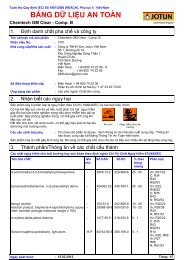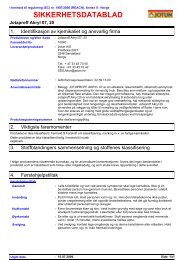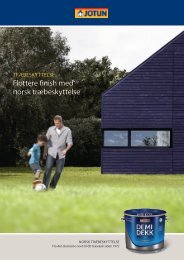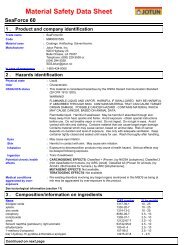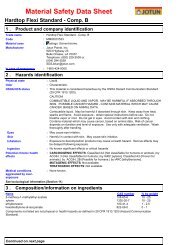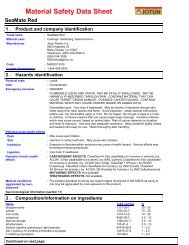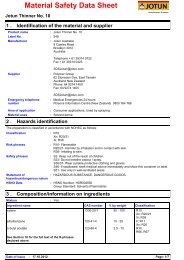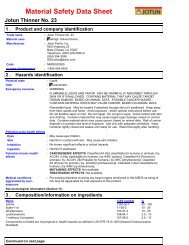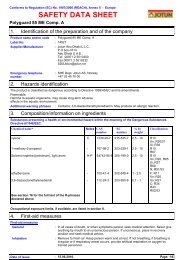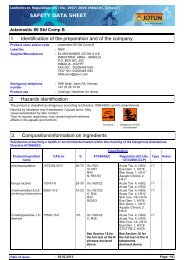Penguard Clear Sealer Comp A - Marine_Protective - English - Jotun
Penguard Clear Sealer Comp A - Marine_Protective - English - Jotun
Penguard Clear Sealer Comp A - Marine_Protective - English - Jotun
- No tags were found...
Create successful ePaper yourself
Turn your PDF publications into a flip-book with our unique Google optimized e-Paper software.
Material Safety Data Sheet<strong>Penguard</strong> <strong>Clear</strong> <strong>Sealer</strong> <strong>Comp</strong> A1 .Identification of the material and supplierProduct name: <strong>Penguard</strong> <strong>Clear</strong> <strong>Sealer</strong> <strong>Comp</strong> ALabel No. : 4265Manufacturer: <strong>Jotun</strong> Australia9 Cawley RoadBrooklyn 3012AustraliaTelephone + 61 39314 0722Fax + 61 39314 0423SDS<strong>Jotun</strong>@jotun.comSupplier: Polymer Group62 Stonedon Dve, East TamakiAuckland New ZealandPhone: 64 9274 1400Fax: 64 9274 1405Emergency telephonenumber:SDS<strong>Jotun</strong>@jotun.comMedical Emergencies 24 hours:Poisons Information Centre (New Zealand) 0800 764 766Area of application : Industrial applications, Used by spraying.Material uses: Primer2 . Hazards identificationThe preparation is classified in accordance with NOHSC as follows:ClassificationRisk phrasesSafety phrasesStatement ofhazardous/dangerous natureHSNO Data:::R10Xn; R20/21Xi; R41, R38R43R10- Flammable.R20/21- Harmful by inhalation and in contact with skin.R41- Risk of serious damage to eyes.R38- Irritating to skin.R43- May cause sensitisation by skin contact.S23- Do not breathe vapour / spray.S26- In case of contact with eyes, rinse immediately with plenty of water and seekmedical advice.S36/37/39- Wear suitable protective clothing, gloves and eye/face protection.S38- In case of insufficient ventilation, wear suitable respiratory equipment.: HAZARDOUS SUBSTANCE. DANGEROUS GOODS.: HSNO Number: HSR002662Group Standard: Surface Coatings and Colourants (Flammable)3 .<strong>Comp</strong>osition/information on ingredientsMixture: Yes.Ingredient name CAS number % by weight Classificationepoxy resin (MW 700-1200) 25036-25-3 25 - 50 Xi; R36/38R43xylene 1330-20-7 25 - 50 R10Xn; R20/21Xi; R38butan-1-ol 71-36-3 10 - 25 R10Xn; R22Xi; R41, R37/38R67Date of issue : 01.11.2012.Page: 1/8
<strong>Penguard</strong> <strong>Clear</strong> <strong>Sealer</strong> <strong>Comp</strong> Aethylbenzene 100-41-4 2.5 - 10 F; R11Xn; R20urea, polymer with formaldehyde, butylated 68002-19-7 1 - 2.5 R53See Section 16 for the full text of the R-phrasesdeclared above.Other ingredients, determined not to be hazardous according to Safe Work Australia criteria, and not dangerousaccording to the ADG Code, make up the product concentration to 100%.4 .First-aid measuresFirst-aid measuresEye contactSkin contactInhalationIngestionProtection of first-aiders::::Get medical attention immediately. Immediately flush eyes with plenty of water,occasionally lifting the upper and lower eyelids. Check for and remove any contactlenses. Continue to rinse for at least 10 minutes. Chemical burns must be treatedpromptly by a physician.Flush contaminated skin with plenty of water. Remove contaminated clothing andshoes. Wash contaminated clothing thoroughly with water before removing it, or weargloves. Continue to rinse for at least 10 minutes. Get medical attention. In the eventof any complaints or symptoms, avoid further exposure. Wash clothing before reuse.Clean shoes thoroughly before reuse.Remove victim to fresh air and keep at rest in a position comfortable for breathing. Ifit is suspected that fumes are still present, the rescuer should wear an appropriatemask or self-contained breathing apparatus. If not breathing, if breathing is irregularor if respiratory arrest occurs, provide artificial respiration or oxygen by trainedpersonnel. It may be dangerous to the person providing aid to give mouth-to-mouthresuscitation. Get medical attention. If unconscious, place in recovery position andget medical attention immediately. Maintain an open airway. Loosen tight clothingsuch as a collar, tie, belt or waistband. In case of inhalation of decompositionproducts in a fire, symptoms may be delayed. The exposed person may need to bekept under medical surveillance for 48 hours.Wash out mouth with water. Remove dentures if any. Remove victim to fresh air andkeep at rest in a position comfortable for breathing. If material has been swallowedand the exposed person is conscious, give small quantities of water to drink. Stop ifthe exposed person feels sick as vomiting may be dangerous. Do not induce vomitingunless directed to do so by medical personnel. If vomiting occurs, the head should bekept low so that vomit does not enter the lungs. Get medical attention if adversehealth effects persist or are severe. Never give anything by mouth to an unconsciousperson. If unconscious, place in recovery position and get medical attentionimmediately. Maintain an open airway. Loosen tight clothing such as a collar, tie, beltor waistband.: No action shall be taken involving any personal risk or without suitable training. It maybe dangerous to the person providing aid to give mouth-to-mouth resuscitation. Washcontaminated clothing thoroughly with water before removing it, or wear gloves.5 .Fire-fighting measuresExtinguishing mediaSuitable :Not suitable :Special exposure hazards :Special protectiveequipment for fire-fightersHazchem code:Use dry chemical, CO2, water spray (fog) or foam.Do not use water jet.Promptly isolate the scene by removing all persons from the vicinity of the incident ifthere is a fire. No action shall be taken involving any personal risk or without suitabletraining. Move containers from fire area if this can be done without risk. Use waterspray to keep fire-exposed containers cool.Flammable liquid. In a fire or if heated, a pressure increase will occur and thecontainer may burst, with the risk of a subsequent explosion. Runoff to sewer maycreate fire or explosion hazard.Fire-fighters should wear appropriate protective equipment and self-containedbreathing apparatus (SCBA) with a full face-piece operated in positive pressuremode.: 3[Y]Date of issue : 01.11.2012.Page: 2/8
6 .<strong>Penguard</strong> <strong>Clear</strong> <strong>Sealer</strong> <strong>Comp</strong> AAccidental release measuresPersonal precautionsEnvironmental precautionsMethods for cleaning up7 .HandlingStorage8 .Handling and storage::No action shall be taken involving any personal risk or without suitable training.Evacuate surrounding areas. Keep unnecessary and unprotected personnel fromentering. Do not touch or walk through spilt material. Shut off all ignition sources. Noflares, smoking or flames in hazard area. Avoid breathing vapour or mist. Provideadequate ventilation. Wear appropriate respirator when ventilation is inadequate. Puton appropriate personal protective equipment (see Section 8).Avoid dispersal of spilt material and runoff and contact with soil, waterways, drainsand sewers. Inform the relevant authorities if the product has caused environmentalpollution (sewers, waterways, soil or air).: Stop leak if without risk. Move containers from spill area. Approach the release fromupwind. Prevent entry into sewers, water courses, basements or confined areas.Wash spillages into an effluent treatment plant or proceed as follows. Contain andcollect spillage with non-combustible, absorbent material e.g. sand, earth, vermiculiteor diatomaceous earth and place in container for disposal according to localregulations (see section 13). Use spark-proof tools and explosion-proof equipment.Dispose of via a licensed waste disposal contractor. Contaminated absorbentmaterial may pose the same hazard as the spilt product. Note: see section 1 foremergency contact information and section 13 for waste disposal.Contain and collect spillage with an electrically protected vacuum cleaner or by wetbrushingand place in container for disposal according to local regulations (seesection 13).::Put on appropriate personal protective equipment (see Section 8). Eating, drinkingand smoking should be prohibited in areas where this material is handled, stored andprocessed. Workers should wash hands and face before eating, drinking andsmoking. Remove contaminated clothing and protective equipment before enteringeating areas. Persons with a history of skin sensitization problems should not beemployed in any process in which this product is used. Do not get in eyes or on skinor clothing. Do not ingest. Avoid breathing vapour or mist. Use only with adequateventilation. Wear appropriate respirator when ventilation is inadequate. Do not enterstorage areas and confined spaces unless adequately ventilated. Keep in the originalcontainer or an approved alternative made from a compatible material, kept tightlyclosed when not in use. Store and use away from heat, sparks, open flame or anyother ignition source. Use explosion-proof electrical (ventilating, lighting and materialhandling) equipment. Use non-sparking tools. Take precautionary measures againstelectrostatic discharges. To avoid fire or explosion, dissipate static electricity duringtransfer by earthing and bonding containers and equipment before transferringmaterial. Empty containers retain product residue and can be hazardous. Do notreuse container.The handle provided on the package is for manual handling only. Transport andtransfer should be carried out with appropriate equipment and carriage devices.Store in accordance with local regulations. Store in a segregated and approved area.Store in original container protected from direct sunlight in a dry, cool and wellventilatedarea, away from incompatible materials (see section 10) and food anddrink. Eliminate all ignition sources. Separate from oxidizing materials. Keepcontainer tightly closed and sealed until ready for use. Containers that have beenopened must be carefully resealed and kept upright to prevent leakage. Do not storein unlabelled containers. Use appropriate containment to avoid environmentalcontamination.Exposure controls/personal protectionIngredient nameExposure limitsxylene Safe Work Australia (Australia, 8/2005).STEL: 655 mg/m³ 15 minute(s).STEL: 150 ppm 15 minute(s).TWA: 350 mg/m³ 8 hour(s).TWA: 80 ppm 8 hour(s).butan-1-olSafe Work Australia (Australia, 8/2005). Absorbedthrough skin.PEAK: 152 mg/m³ 15 minute(s).PEAK: 50 ppm 15 minute(s).ethylbenzene ASCC (Australia, 8/2005).Date of issue : 01.11.2012.Page: 3/8
<strong>Penguard</strong> <strong>Clear</strong> <strong>Sealer</strong> <strong>Comp</strong> ARecommended monitoringproceduresEngineering measuresHygiene measures::STEL: 543 mg/m³ 15 minute(s).STEL: 125 ppm 15 minute(s).TWA: 434 mg/m³ 8 hour(s).TWA: 100 ppm 8 hour(s).: If this product contains ingredients with exposure limits, personal, workplaceatmosphere or biological monitoring may be required to determine the effectivenessof the ventilation or other control measures and/or the necessity to use respiratoryprotective equipment.Use only with adequate ventilation. Use process enclosures, local exhaust ventilationor other engineering controls to keep worker exposure to airborne contaminantsbelow any recommended or statutory limits. The engineering controls also need tokeep gas, vapour or dust concentrations below any lower explosive limits. Useexplosion-proof ventilation equipment.Wash hands, forearms and face thoroughly after handling chemical products, beforeeating, smoking and using the lavatory and at the end of the working period.Appropriate techniques should be used to remove potentially contaminated clothing.Contaminated work clothing should not be allowed out of the workplace. Washcontaminated clothing before reusing. Ensure that eyewash stations and safetyshowers are close to the workstation location.Personal protectionEyes:Safety eyewear complying with an approved standard should be used when a riskassessment indicates this is necessary to avoid exposure to liquid splashes, mists ordusts.HandsRespiratorySkinEnvironmental exposurecontrols9 .:::Chemical-resistant, impervious gloves complying with an approved standard shouldbe worn at all times when handling chemical products if a risk assessment indicatesthis is necessary.Use a properly fitted, air-purifying or air-fed respirator complying with an approvedstandard if a risk assessment indicates this is necessary. Respirator selection mustbe based on known or anticipated exposure levels, the hazards of the product and thesafe working limits of the selected respirator.Personal protective equipment for the body should be selected based on the taskbeing performed and the risks involved and should be approved by a specialist beforehandling this product.: Emissions from ventilation or work process equipment should be checked to ensurethey comply with the requirements of environmental protection legislation. In somecases, fume scrubbers, filters or engineering modifications to the process equipmentwill be necessary to reduce emissions to acceptable levels.Physical and chemical propertiesPhysical state: Liquid.Colour: <strong>Clear</strong>.OdourDensity::Characteristic.0.98 g/cm 3Flash point: Closed cup: 25°C (77°F)Solubility: Insoluble in the following materials: cold water and hot water.10 .Stability and reactivityStability :Stable under recommended storage and handling conditions (see section 7).Hazardous decomposition products: carbon monoxide, carbon dioxide, smoke, oxidesof nitrogen.Keep away from the following materials to prevent strong exothermic reactions:oxidising agents, strong alkalis, strong acids.Hazardous decompositionproductsMaterials to avoid/Hazardous Reactions: Decomposition products may include the following materials: carbon monoxide,carbon dioxide, smoke, oxides of nitrogen.:Keep away from the following materials to prevent strong exothermic reactions:oxidising agents, strong alkalis, strong acids.Date of issue : 01.11.2012.Page: 4/8
<strong>Penguard</strong> <strong>Clear</strong> <strong>Sealer</strong> <strong>Comp</strong> AConditions to avoid: Keep away from heat, sparks and flame.11 .Toxicological informationThere are no data available on the preparation itself. The preparation has been assessed following the conventional methodof the Dangerous Preparations Directive 1999/45/EC and classified for toxicological hazards accordingly. See sections 2 and15 for details.Exposure to component solvent vapour concentrations in excess of the stated occupational exposure limit may result inadverse health effects such as mucous membrane and respiratory system irritation and adverse effects on the kidneys, liverand central nervous system. Symptoms and signs include headache, dizziness, fatigue, muscular weakness, drowsiness and,in extreme cases, loss of consciousness.Solvents may cause some of the above effects by absorption through the skin. Repeated or prolonged contact with thepreparation may cause removal of natural fat from the skin, resulting in non-allergic contact dermatitis and absorption throughthe skin.If splashed in the eyes, the liquid may cause irritation and reversible damage.Ingestion may cause nausea, diarrhea and vomiting.This takes into account, where known, delayed and immediate effects and also chronic effects of components from shorttermand long-term exposure by oral, inhalation and dermal routes of exposure and eye contact.Contains epoxy resin (MW 700-1200). May produce an allergic reaction.Risk of serious damage to eyes.Potential acute health effectsInhalationIngestionSkin contactEye contactAcute toxicityToxicity data: Not available.Potential chronic health effectsCarcinogenicityMutagenicityReproductive toxicityOver-exposure signs/symptomsInhalationIngestionSkinTarget organs::::::::::Harmful by inhalation. Exposure to decomposition products may cause a healthhazard. Serious effects may be delayed following exposure.Irritating to mouth, throat and stomach.Harmful in contact with skin. Irritating to skin. May cause sensitisation by skin contact.Severely irritating to eyes. Risk of serious damage to eyes.Ingredient name ACGIH EPA OSHA IARC NIOSH NTPxylene A4 - - 3 - -ethylbenzene A3 - - 2B - -No known significant effects or critical hazards.No known significant effects or critical hazards.No known significant effects or critical hazards.No known significant effects or critical hazards.No known significant effects or critical hazards.Contains material which may cause damage to the following organs: mucousmembranes, upper respiratory tract, skin, central nervous system (CNS), ears, eye,lens or cornea.12 .Ecological informationThere are no data available on the preparation itself.Do not allow to enter drains or watercourses.The preparation has been assessed following the conventional method of the Dangerous Preparations Directive1999/45/EC and is not classified as dangerous for the environment but contains a substance or substances dangerousfor the environment. See section 2 for details.EcotoxicityAquatic ecotoxicity: No known significant effects or critical hazards.Product/ingredient nameResultSpeciesExposureethylbenzene Acute EC50 7,2 mg/L Algae 48 hoursAcute EC50 2,93 mg/L Daphnia 48 hoursAcute LC50 4,2 mg/L Fish 96 hoursConclusion/SummaryOther ecological information: Not available.Date of issue : 01.11.2012.Page: 5/8
<strong>Penguard</strong> <strong>Clear</strong> <strong>Sealer</strong> <strong>Comp</strong> APersistence/degradabilityConclusion/SummaryProduct/ingredient name Aquatic half-life Photolysis Biodegradabilityxylene - - Readilyethylbenzene - - ReadilyBioaccumulative potentialProduct/ingredient name LogPow BCF Potentialxylene 3,12 - highbutan-1-ol 0,88 - lowOther adverse effects13 .Methods of disposal14 .: Not available.Disposal considerationsTransport information: No known significant effects or critical hazards.: The generation of waste should be avoided or minimised wherever possible. Emptycontainers or liners may retain some product residues. This material and its containermust be disposed of in a safe way. Significant quantities of waste product residuesshould not be disposed of via the foul sewer but processed in a suitable effluenttreatment plant. Dispose of surplus and non-recyclable products via a licensed wastedisposal contractor. Disposal of this product, solutions and any by-products should atall times comply with the requirements of environmental protection and wastedisposal legislation and any regional local authority requirements. Avoid dispersal ofspilt material and runoff and contact with soil, waterways, drains and sewers.Transport within user’s premises: always transport in closed containers that are upright and secure. Ensure thatpersons transporting the product know what to do in the event of an accident or spillage.International transport regulationsProper shipping name : Resin solutionUN Number : 1866Class : 3Packing group:Label :IIIAdditional informationADG Proper shipping nameADG Label::Resin solutionADG Hazchem code : 3[Y]ADR / RID: Tunnel restriction code: (E)Hazard identification number: 30Special provisions: 640EIMDG: Emergency schedules (EmS): F-E, S-E<strong>Marine</strong> pollutant: No.Transport in accordance with ADR/RID, IMDG/IMO and ICAO/IATA and national regulation.15 .Regulatory informationNational regulationsStandard for the Uniform Scheduling of Drugs and PoisonsNot regulated.Control of Scheduled Carcinogenic SubstancesIngredient nameNo listed substanceScheduleDate of issue : 01.11.2012.Page: 6/8
<strong>Penguard</strong> <strong>Clear</strong> <strong>Sealer</strong> <strong>Comp</strong> AAustralia inventory (AICS)New Zealand Inventory ofChemicals (NZIoC)HSNO DataHSNO ClassificationEU regulationsHazard symbol orsymbols: All ingredients are listed on AICS or are exempt.: All components listed or exempt from listing on the New Zealand Inventory ofChemicals (NZIoC).: HSNO Number: HSR002662Group Standard: Surface Coatings and Colourants (Flammable): 3.1 - FLAMMABLE LIQUIDS - Category C6.1 - ACUTE TOXICITY: ORAL - Category D6.1 - ACUTE TOXICITY: SKIN - Category E6.3 - SKIN IRRITATION - Category A8.3 - CORROSIVE TO OCULAR TISSUE - Category A6.5 - SENSITIZATION - Category B (Skin)6.8 - REPRODUCTIVE AND DEVELOPMENTAL TOXICITY [Fertility] - Category B6.8 - REPRODUCTIVE AND DEVELOPMENTAL TOXICITY [Unborn child] -Category B6.9 - SPECIFIC TARGET ORGAN TOXICITY (SINGLE OR REPEATEDEXPOSURE): ORAL - Category B6.9 - SPECIFIC TARGET ORGAN TOXICITY (SINGLE OR REPEATEDEXPOSURE): INHALATION - Category B9.1 - AQUATIC ECOTOXICITY - Category D9.3 - TERRESTRIAL VERTEBRATE ECOTOXICITY - Category C: The product is classified and labelled for supply in accordance with the Directive1999/45/EC as follows::HarmfulContainsRisk phrases::epoxy resin (MW 700-1200)xyleneR10- Flammable.R20/21- Harmful by inhalation and in contact with skin.R41- Risk of serious damage to eyes.R38- Irritating to skin.R43- May cause sensitisation by skin contact.Safety phrases :US regulationsHCS Classification16 .Other informationFull text of R-phrases referredto in sections 2 and 3S23- Do not breathe vapour / spray.S26- In case of contact with eyes, rinse immediately with plenty of water and seekmedical advice.S36/37/39- Wear suitable protective clothing, gloves and eye/face protection.S51- Use only in well-ventilated areas.: Flammable liquidCarcinogenTarget organ effectsNotice to readerHistoryDate of printing: 01.11.2012.Date of issueVersion::01.11.2012.2: R11- Highly flammable.R10- Flammable.R20- Harmful by inhalation.R22- Harmful if swallowed.R20/21- Harmful by inhalation and in contact with skin.R41- Risk of serious damage to eyes.R38- Irritating to skin.R36/38- Irritating to eyes and skin.R37/38- Irritating to respiratory system and skin.R43- May cause sensitisation by skin contact.R67- Vapours may cause drowsiness and dizziness.R53- May cause long-term adverse effects in the aquatic environment.Date of issue : 01.11.2012.Page: 7/8
<strong>Penguard</strong> <strong>Clear</strong> <strong>Sealer</strong> <strong>Comp</strong> APrepared by: <strong>Jotun</strong> Group Product Safety DepartmentDisclaimerTo the best of our knowledge, the information contained herein is accurate. However, neither the above-named supplier,nor any of its subsidiaries, assumes any liability whatsoever for the accuracy or completeness of the informationcontained herein.Final determination of suitability of any material is the sole responsibility of the user. All materials may present unknownhazards and should be used with caution. Although certain hazards are described herein, we cannot guarantee thatthese are the only hazards that exist.Date of issue : 01.11.2012.Page: 8/8



